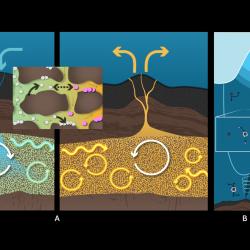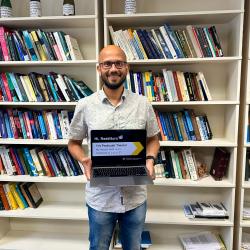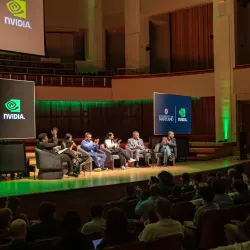Catching Space Waves and Demystifying Black Holes
Astrophysicist Kayhan Gultekin (M.S. ’02, Ph.D. ’06, astronomy) helped analyze the first evidence of gravitational waves passing through the Milky Way—signals likely launched into space by supermassive black holes.

Studying one supermassive black hole is hard enough, but astrophysicist Kayhan Gultekin (M.S. ’02, Ph.D. ’06, astronomy) explores what happens when two of these celestial objects converge.
As an associate professor of astronomy at the University of Michigan, Gultekin researches supermassive black holes, their extreme environments and how they affect their host galaxies. He’s particularly interested in pairs of black holes, including supermassive black hole binaries—an elusive phenomenon in which two of these behemoths orbit each other and eventually merge.
Though supermassive black hole binaries are not well understood, Gultekin saw strong hints of their existence in data collected over 15 years by the North American Nanohertz Observatory for Gravitational Waves (NANOGrav).
In June 2023, the observatory announced it had found the first evidence of low-frequency gravitational waves passing through the Milky Way—ripples in space-time created, in part, by the merging of black holes. Albert Einstein predicted these waves in the 1900s, but NANOGrav was the first to detect them on a galactic scale.
“It was not unexpected, but it was still quite a thrill,” Gultekin said. “Einstein's general theory of relativity passes a mild test, with stricter tests to come.”
Through his collaboration with NANOGrav, Gultekin played a significant—and exciting—role in interpreting the data and providing evidence of these gravitational waves and their origin.
“Getting the astrophysical interpretation together was a rush—a lot of sleepless nights in April, May and June of that year,” he recalled. “Of course, behind the scenes, every analysis was done a gazillion times to confirm that the signal was definitely there.”
He said their findings strongly suggest that these waves came from many pairs of black holes outside of the Milky Way, which traversed vast distances before being detected by NANOGrav. While it has not been definitively proven that these specific space waves come from black hole binaries, Gultekin’s ongoing interpretations of NANOGrav data could help strengthen that case.
“What the data show is that there’s a population of binary supermassive black holes at moderate cosmological distances that are all, in a sense, ringing in gravitational waves,” Gultekin said. “Although we can't rule out other exotic possibilities yet, I personally think it’s the best explanation.”
How massive is supermassive?
For Gultekin, having the chance to work on such enigmatic problems is something he’s dreamed about since he first became fascinated with space in high school.
“Space was one of the many things that interested me about science,” he said. “I got into it in 10th grade when I read Stephen Hawking's ‘A Brief History of Time’ and it sparked my interest in theoretical physics and black holes. The fact that humanity had figured all these problems just by thinking hard enough fascinated me.”
After graduating from high school, he earned his bachelor’s degree in physics from the University of Pennsylvania. He then enrolled in the University of Maryland’s astronomy graduate program to study star and planet formation, but he ultimately changed tracks after Professor Cole Miller invited him to work on a black hole research project.
“It turned out to be fun and stimulating, and it reminded me what I wanted to work on to begin with: theoretical studies of black holes,” Gultekin said.

Gultekin welcomed two children into the world while working toward his Ph.D., ultimately earning his degree in 2006. He has been studying black holes ever since, contributing to more than 160 research publications—including more than 40 as a first author.
Over the last year, Gultekin has helped determine the masses of a supermassive black hole in the elliptical galaxy NGC 3258 as well as another one in NGC 4826, which is also called the “Black Eye Galaxy” or “Evil Eye Galaxy” for its dark wall of dust surrounding a bright nucleus. The latter effort involved using Hubble telescope images, leading Gultekin to remark that NGC 4826 is possibly “the most beautiful galaxy” he’s ever studied.
Ultimately, determining a supermassive black hole’s proportions—the largest of which can have masses 28 billion times greater than that of the sun—can reveal other key details about their environments.
“We use modeling data to measure black hole masses and to figure out what that tells us about the relationship between the black holes and the galaxies they live in,” Gultekin explained.
Turning back cosmic time
In his current research, Gultekin continues to explore some of the biggest unanswered questions in his field: How quickly do supermassive black holes merge, and can that be determined with gravitational wave data? Were supermassive black holes larger in the past relative to the size of their host galaxies?
He’s also helping to lay the scientific groundwork for a space probe planned for 2035 called the Laser Interferometer Space Antenna (LISA). Operated by NASA and the European Space Agency, LISA will launch three spacecraft to detect passing gravitational waves and, consequently, black holes.
Gultekin said LISA will broaden scientists’ understanding of a wider variety of black holes, complementing existing observatories like NANOGrav and the Laser Interferometer Gravitational-Wave Observatory (LIGO) operated by Caltech and MIT.
“LISA will be sensitive to a higher frequency, which in turn means it's sensitive to lower-mass black holes than NANOGrav,” Gultekin explained. “It’s a very different regime of astrophysics that will tell us a lot about how supermassive black holes form, especially in the early universe.”
Throughout his career, Gultekin has been at the forefront of black hole and gravitational wave discoveries that have rapidly advanced the field. Going forward, he hopes to solve even more mysteries about enigmatic phenomena.
“I got my Ph.D. in 2006, so this was before gravitational waves had been detected directly,” he said. “Pairs of black holes are one of the best ways to make gravitational waves, so it's a very exciting time to study this field and to be able to see back in cosmic time.”







